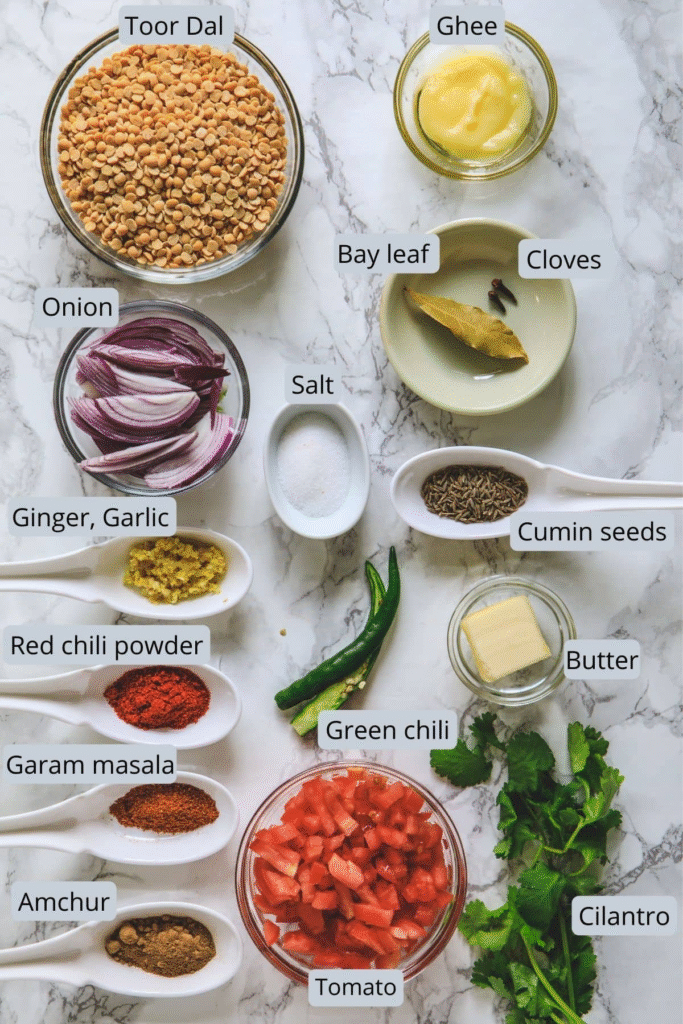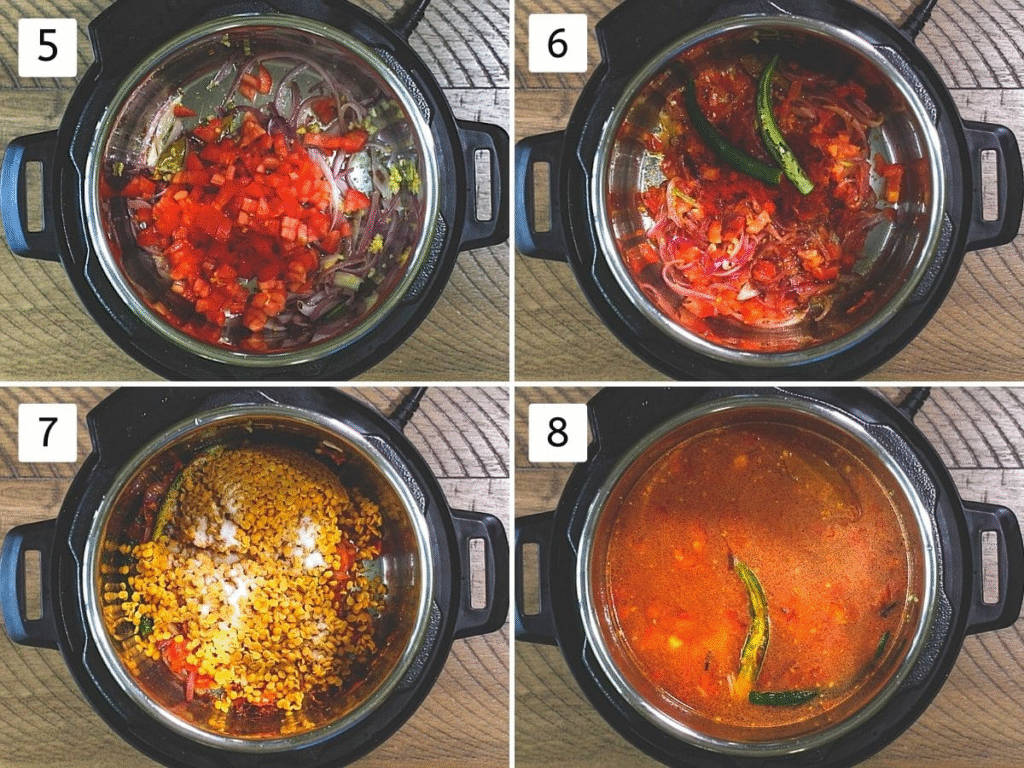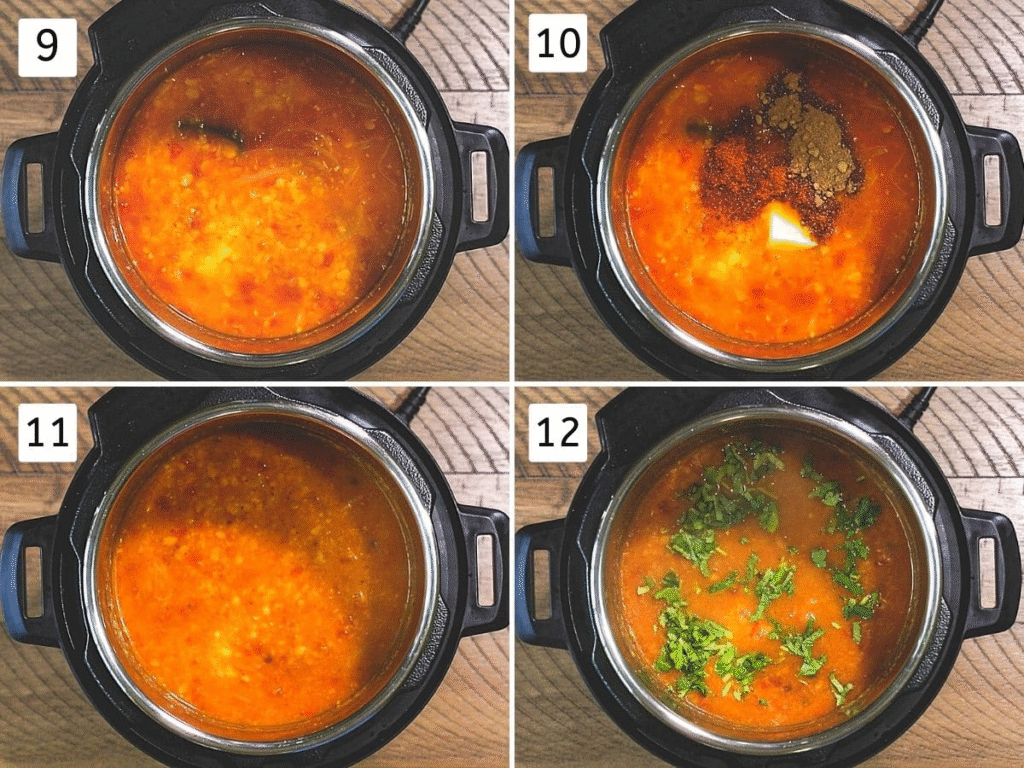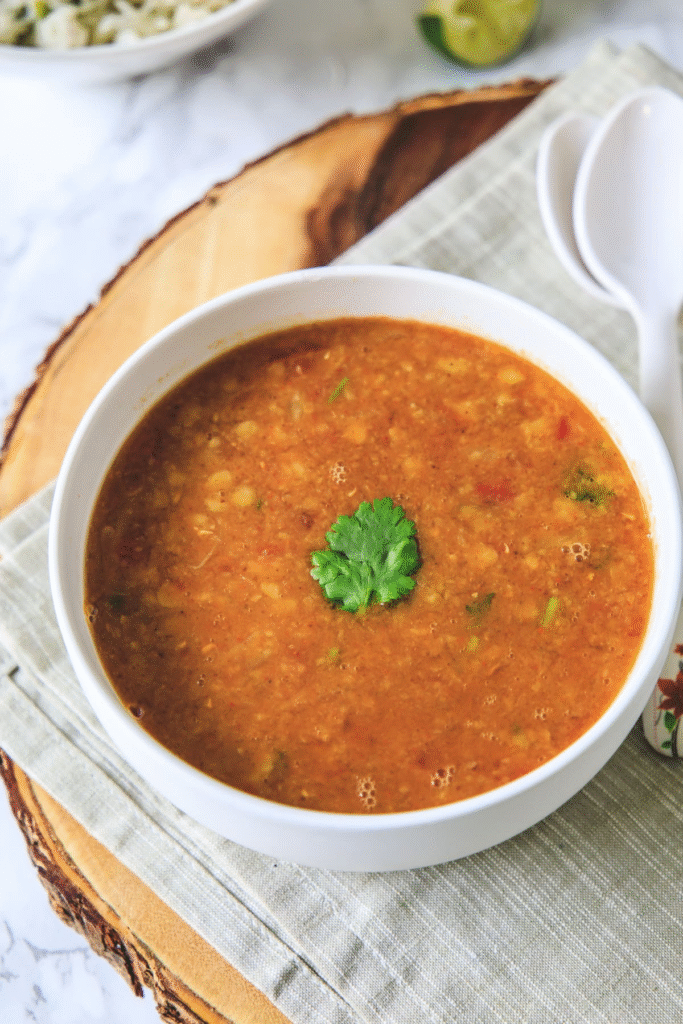This soul-warming Punjabi-style toor dal (also known as arhar dal) is a wholesome dish made using yellow split pigeon peas, slow-cooked with onions, tomatoes, and everyday Indian spices. Each spoonful delivers a perfect balance of earthy, tangy, and subtly spicy notes that define North Indian home-style cooking.
Light yet nourishing, this dal makes for a satisfying everyday meal. Pair it with a bowl of steaming hot basmati rice or lightly spiced pulao. Round out the meal with crispy papad, a spoonful of spicy carrot pickle, and a crunchy kachumber salad on the side.

❤️ About This Toor Dal Recipe
- This Punjabi-style arhar dal recipe is a comforting, homestyle dish that’s quick and easy to prepare, making it ideal for everyday cooking. With just a few basic ingredients and straightforward steps, you can whip up a wholesome meal in no time.
- Toor dal, also known as arhar dal, is one of the most widely used lentils in Indian households. It’s a staple across many states, and each region lends its own signature touch to it. Take, for example, the sweet-tangy notes of Gujarati dal, the mild and comforting Varan Bhaat from Maharashtra, the earthy, spicy flavors of Andhra-style Pappu, or the tamarind-kissed richness of South Indian sambar — all united by one humble ingredient: toor dal. as the base—yet taste completely different. This version follows the hearty, robust Punjabi style, which is known for its onion-tomato tadka and bold flavors.
- This dal has a balanced, medium consistency—neither overly thick nor too runny—making it an ideal match for both soft Indian flatbreads like roti or paratha and comforting rice-based meals like steamed basmati or jeera rice.. However, preferences vary from person to person. If you enjoy a thinner dal to mix with rice, simply add a little warm water to loosen the texture to your liking before serving.
🧾 Ingredient Notes
Here is the pic of the ingredients used in making this delicious instant pot toor dal. All of them are basic and easily available.

- Toor Dal (also known as Arhar Dal): This yellow split pigeon pea is a staple in Indian kitchens and is available in two forms at most Indian grocery stores—dry and oil-coated. The dry version is simply the cleaned lentil, while the oil-coated one has a thin layer of castor oil applied. The oil acts as a natural preservative, enhancing shelf life and protecting the lentils from insect infestation, which is particularly useful in the Indian climate. Traditionally, in many Indian households, lentils, grains, and spices are bought in bulk—enough to last a year—and are stored in large containers after being treated with oil to prevent spoilage.
- Dry vs. Oily Dal – Which One to Use? Both versions cook up the same and taste identical once prepared. Personally, living in the USA where I don’t store pantry staples for more than 2–3 months, I usually buy the dry, non-oily toor dal. It’s more convenient and doesn’t require rinsing off the oil, though if you do use the oily version, a good rinse under warm water will take care of it.
- Ghee and Butter: These two ingredients are signature elements of Punjabi cuisine, known for its bold and indulgent flavors. Ghee lends a nutty aroma and depth, while butter contributes a luxurious, creamy texture. For everyday cooking, I often stick to ghee alone for health reasons, but when preparing dal for guests or special occasions, I add both for that authentic Punjabi richness.
- Onion: In most Indian recipes, red onions are preferred because of their sharp flavor and slightly sweet undertones when cooked. They caramelize beautifully and form a rich base for the masala.
- Tomato: Use Roma or plum tomatoes for best results in Indian cooking. These tomatoes are less watery, more pulpy, and offer a deeper, sweeter flavor that balances the spices. Always opt for ripe, red tomatoes for the most vibrant taste and color.
- Ginger-Garlic: Freshly ground ginger and garlic make a noticeable difference in flavor. I typically grind them in the small wet jar of my spice grinder right before cooking. Of course, store-bought ginger-garlic paste works fine when you’re in a rush, but for special meals, fresh is always better.
- Amchur (Dry Mango Powder): Instead of adding lemon or lime juice at the end—as is common in many dal recipes—this Punjabi toor dal uses amchur to deliver that subtle tanginess. It imparts a unique, slightly fruity sourness that brightens the dish and complements the earthiness of the lentils beautifully. It’s a small addition that makes a big difference and gives the dal a flavor profile that stands out.
👩🍳 How To Make Instant Pot Toor Dal? (Stepwise)
1) Set your Instant Pot to sauté mode. Once it’s hot, add ghee and let it melt completely.
2) Toss in a bay leaf and a couple of cloves. Sauté them for 30–40 seconds until aromatic, then add cumin seeds and let them crackle.
3) Add the sliced onions. Sauté for 3–4 minutes, or until they turn soft and light golden-pink.
4) Mix in freshly minced ginger and garlic. Sauté for about a minute until their raw aroma disappears.

5) Stir in the chopped tomatoes. Cook them down until they soften and become mushy.
6) Then add red chili powder, turmeric powder and slit green chili. Mix well.
7) Add the rinsed toor dal along with salt.
8) Add water, stir well. Cover the instant pot with a lid. Cancel the saute mode. Pressure cook on manual (high pressure) for 5 minutes.

9) Allow the pressure to release naturally (NPR). Once the safety pin drops, carefully open the lid.
10) Stir in a dash of garam masala and a pinch of amchur powder for that warm spice and tangy lift. Finish with a dollop of butter that melts into the dal, enriching it with a velvety smooth texture and indulgent flavor.
11) Stir thoroughly to combine. If needed, switch back to sauté mode to reheat before serving.
12) Garnish with freshly chopped cilantro just before serving for a burst of freshness.

💭 Expert Tips
- Toor dal naturally thickens as it rests: When you first open the pressure cooker lid, you might feel like the dal has a thin or watery consistency. But don’t worry—it will gradually thicken as it cools and sits for 5 to 10 minutes. So always check the consistency after a brief resting period before deciding to simmer it again.
- Butter vs. ghee in daily cooking: If you’re making this dal as part of your regular meal routine, feel free to skip adding butter. Ghee alone provides a wonderful aroma and deep, nutty flavor that enhances the taste of the dal without making it too rich. Butter can be reserved for special occasions when you want that extra indulgent, creamy finish.
- Vegan-friendly variation: To make this dal completely plant-based, simply substitute ghee with any neutral cooking oil like sunflower, avocado, or mustard oil (for a pungent kick). Also, avoid butter entirely. You’ll still end up with a delicious, comforting dal that’s wholesome and dairy-free.
- Time-saving trick—Cook rice using PIP (Pot-in-Pot) method: You can cook basmati rice at the same time as your dal using the Pot-in-Pot technique, saving both time and effort.
- 1 cup Basmati rice, 1 ½ cups Water, ½ Salt or as per your taste.
- Add the rinsed rice to a stainless steel container or Instant Pot-safe bowl.
- Pour in 1½ cups of water along with about ½ teaspoon of salt (adjust as per your taste).
- Now place a tall trivet (a stand that keeps the bowl above the dal) inside the Instant Pot insert, which already contains your uncooked dal.
- Set the rice bowl on top of the trivet and cover it loosely with a lid or plate to prevent water from dripping in.
- Close the Instant Pot lid and cook everything under pressure using the settings specified for the dal recipe.
This method allows you to prepare a complete meal—steamed rice and flavorful toor dal—all in one go, with minimal cleanup and perfect timing.
🍽 How To Serve Toor Dal?
- Toor dal pairs wonderfully with a variety of rice dishes such as plain steamed rice, jeera rice, or a mildly spiced peas pulao. The comforting and earthy flavors of the dal complement the aromatic basmati rice beautifully, creating a wholesome and satisfying meal. To enhance the dining experience, serve it with crispy roasted or fried papad, a tangy Indian pickle (like mango or lemon), and a refreshing kachumber salad made with finely chopped cucumber, onion, and tomatoes, dressed with lemon juice and a pinch of chaat masala.
- This flavorful arhar dal can also be enjoyed with Indian breads like soft rotis, flaky parathas, or buttery garlic naan. The warm, spiced dal is perfect for scooping up with these breads, making it an excellent option for lunch or dinner. Add a dollop of ghee or butter on top for a richer taste, and round out the meal with accompaniments such as a bowl of curd or raita, a side of sautéed vegetables, and a glass of chilled salted lassi for a truly comforting and nourishing Indian meal experience.

